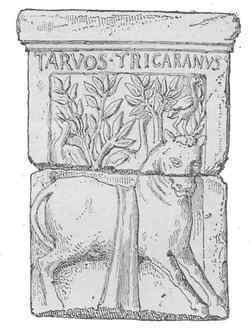The Bull in Irish & Celtic Mythology- Part 1
 There is an altar in Paris bearing the inscription “Tarvos Trigaranus”, which means ‘Bull with three cranes’ (as in, birds). Carved in relief is a tree with spreading branches, in front of which stands a bull, with two of the birds perched on it’s back, and the third on it’s head.
There is an altar in Paris bearing the inscription “Tarvos Trigaranus”, which means ‘Bull with three cranes’ (as in, birds). Carved in relief is a tree with spreading branches, in front of which stands a bull, with two of the birds perched on it’s back, and the third on it’s head.In the Gundestrup cauldron (found in Denmark, and dating from the first century BCE), which is decorated in detail both outside and inside in high relief, we see a depiction of the hunting/imminent killing of a huge bull on the interior base plate. A warrior or deity is about to spear the neck of the prostrate bull, which far out-scales him. There are also dogs present, which may lend weight to the possibility of it being a hunting scene.
Pronsias MacCana (‘Celtic Mythology’: Littlehampton Book Services, 1969) links the Irish Donn Cuailgne, Brown Bull of Cooley, to Tarvos Trigaranus, which he calls the ‘three horned Bull’ - indeed he states the two can “scarcely be dissassociated”. He goes on to speak of “a number of widely attested names which seem to imply familiarity with the notion of a bull-deity”, such as the Gaulish name Donnotaurus, which means ‘Brown, or Kingly, Bull’. In this case, the Irish epic Táin Bó Cuailgne takes on quite a deeper meaning than the simple theme of overly hormonal bulls having a bit of a territorial spat. The two great beasts were never of this world, having reached those forms by changing originally from swineherds of two lords of the Otherworld, through a series of forms including ravens, stags, warrior champions, water beasts, demons and water worms.
 Bull symbolism appears in vast quantities when dealing with the Celtic world. From ritual deposits and sacrifices in the late Bronze Age, to carving and other artistic representation of bull figures, to place-names and tribal names representing the animal, and also taking into account the traditions of cattle raiding and ranching which were/are so prominent in Ireland particularly - we see the bull itself, or possibly deity connected with bulls, as a highly significant figure.
Bull symbolism appears in vast quantities when dealing with the Celtic world. From ritual deposits and sacrifices in the late Bronze Age, to carving and other artistic representation of bull figures, to place-names and tribal names representing the animal, and also taking into account the traditions of cattle raiding and ranching which were/are so prominent in Ireland particularly - we see the bull itself, or possibly deity connected with bulls, as a highly significant figure. World-wide, bulls represent powers of strength, fierceness, and virility, and we have no reason to doubt that the Irish viewed their bulls any other way.
Bull statuary and iconography survives mainly in Gaulish, and some British finds. Being an unnatural form, the triple horned bull mentioned above seems to have been particularly a sacred image. This carries through when we see it being found in shrines, temples, and even the grave of a child (Colchester, England). Perhaps the triplication of the horns is a way of increasing the potency of the animal’s fertility and virility power; three horns are better than two! Three is also a power number in itself in Irish and Celtic cultures, showing up many times over in relation to many different things.
Come back for Part Two next week, and please share the post on Facebook or Twitter if you like it!
Published on March 15, 2014 04:11
No comments have been added yet.



